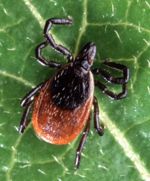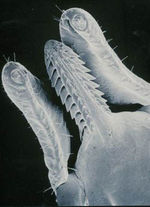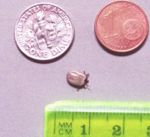Difference between revisions of "Tick Morphology"
| (9 intermediate revisions by 3 users not shown) | |||
| Line 1: | Line 1: | ||
[[Image:Deer tick.jpg|thumb|right|150px|Deer tick - Scott Bauer]] | [[Image:Deer tick.jpg|thumb|right|150px|Deer tick - Scott Bauer]] | ||
| + | ===Gross Morphology=== | ||
| + | Ticks have 2 body parts, the capitulum or gnathosoma is the head part on which the mouthparts are located. The idiosoma is the main body part and contains the mojor organs of the tick, the eyes if they are present are also located on the idiosoma. Ticks are members of the order metastigmata, meaning they have complex breathing apparatus, these are known as '''spiracles''' and are located on either side of the idiosoma and allow gas exchange to take place whilst the ticks mouthparts are used solely for feeding. | ||
| + | |||
===Hard ticks=== | ===Hard ticks=== | ||
| − | + | Hard ticks are so called due to the presence of a hard, chitinous covering on the dorsal surface called the '''scutum'''. In males this scutum covers the entire body surface, however in females only a small area behind the head is covered. The lack of hard covering in females allows much greater engorgement during feeding, up to three times their unfed size. Hard ticks have prominent biting mouthparts on the capitulum used for attachment to the host and for feeding. | |
| − | + | The body of hard ticks can be either ornate, with coloured enamal patches on the scutum, or inornate. Around the posterior body margin of these ticks festoons ('pie crust edging') can be seen. | |
| − | |||
| − | |||
| − | |||
| − | |||
| − | |||
| − | |||
| − | |||
| − | |||
| − | |||
| − | |||
| − | |||
===Soft ticks=== | ===Soft ticks=== | ||
| − | + | Soft ticks lack a dorsal scutum as found in hard ticks and instead have a leathery cuticle. The cuticle coveres the entire dorsal surface of the tick and so the mouthparts cannot been seen from above. Although soft ticks do expand during feeding they cannot do so to as great an extent as hard ticks, as a result these ticks tend to feed in smaller portions but more frequently. | |
| − | + | ===Mouthparts=== | |
| + | [[File:Mouthparts of Ixodes Holocyclus.jpg|150px|thumb|right|Moputhparts of Ixodes Holocyclus - Kevin Broady, Wikimedia Commons]] | ||
| − | + | There are 3 major constituents of the mouthparts of ticks; palps, chelicerae and the hypostome. The palps are sensory organs on protuding on either side of the capitulum, they are used to locate a suitable site for feeding. Once a suitable feeding site has been located the sharp chelicerae are used to create a puncture wound in the skin of the host. The hypostome is then pushed through the wound into the host, where it attaches using backwards facing teeth. A dorsal groove on the hypostome allows the downward flow of tick saliva into the host as well as the upward flow of host blood during tick feeding. | |
| − | == | + | ===Feeding=== |
| − | |||
| − | |||
| − | |||
| − | |||
| − | |||
| − | |||
| − | |||
| − | |||
| − | == | ||
[[Image:Engorged Ixodes scapularis.jpg|thumb|right|150px|Engorged ''Ixodes scapularis'' - Thomas Hedden]] | [[Image:Engorged Ixodes scapularis.jpg|thumb|right|150px|Engorged ''Ixodes scapularis'' - Thomas Hedden]] | ||
| − | |||
| − | |||
| − | |||
| − | * | + | During feeding the tick stands upright to penetrate the skin of the host with well adapted mouthparts. Once inserted the mouthparts are cemented in place by backwards facing teeth and in hard ticks the excretion of cement. Ticks utilise the same groove in the hypostome to secret saliva into the host and draw blood. Tick saliva contains seeveral important substances to aid the ticks feeding; |
| + | *Histamine blocking agents - minimise the hosts inlfammatory response. | ||
| + | *Anticoagulants - ensure the free flow of blood and prevent clot formation | ||
| + | *Cytolysins - enlarge the feeding lesion | ||
| + | *Vasoactive mediators, enterases and carbohydrate splitting enzymes - increase vascular permeability | ||
| + | *Paralytic toxins - prevent host movement e.g. scratching, biting to remove tick. | ||
| + | All of the above mechanisms enable the tick to effectively and succesfully counter the hosts defenses and feed successfully. | ||
| + | During feeding excess water is passed back into the host via the hypostome as the tick is unable to remove water via its cuticle, this allows greater intake of blood from the host. | ||
| − | + | ==Test yourself with the Ticks Flashcards== | |
| − | + | [[Ticks_Flashcards|Ticks Flashcards]] | |
| − | |||
| − | |||
| − | |||
| − | |||
| − | |||
| − | |||
| − | + | {{unfinished}} | |
| − | [[Category:To_Do_- | + | [[Category:Ticks|A]] |
| + | [[Category:To_Do_-_Parasites]] | ||
Latest revision as of 17:35, 24 May 2011
Gross Morphology
Ticks have 2 body parts, the capitulum or gnathosoma is the head part on which the mouthparts are located. The idiosoma is the main body part and contains the mojor organs of the tick, the eyes if they are present are also located on the idiosoma. Ticks are members of the order metastigmata, meaning they have complex breathing apparatus, these are known as spiracles and are located on either side of the idiosoma and allow gas exchange to take place whilst the ticks mouthparts are used solely for feeding.
Hard ticks
Hard ticks are so called due to the presence of a hard, chitinous covering on the dorsal surface called the scutum. In males this scutum covers the entire body surface, however in females only a small area behind the head is covered. The lack of hard covering in females allows much greater engorgement during feeding, up to three times their unfed size. Hard ticks have prominent biting mouthparts on the capitulum used for attachment to the host and for feeding. The body of hard ticks can be either ornate, with coloured enamal patches on the scutum, or inornate. Around the posterior body margin of these ticks festoons ('pie crust edging') can be seen.
Soft ticks
Soft ticks lack a dorsal scutum as found in hard ticks and instead have a leathery cuticle. The cuticle coveres the entire dorsal surface of the tick and so the mouthparts cannot been seen from above. Although soft ticks do expand during feeding they cannot do so to as great an extent as hard ticks, as a result these ticks tend to feed in smaller portions but more frequently.
Mouthparts
There are 3 major constituents of the mouthparts of ticks; palps, chelicerae and the hypostome. The palps are sensory organs on protuding on either side of the capitulum, they are used to locate a suitable site for feeding. Once a suitable feeding site has been located the sharp chelicerae are used to create a puncture wound in the skin of the host. The hypostome is then pushed through the wound into the host, where it attaches using backwards facing teeth. A dorsal groove on the hypostome allows the downward flow of tick saliva into the host as well as the upward flow of host blood during tick feeding.
Feeding
During feeding the tick stands upright to penetrate the skin of the host with well adapted mouthparts. Once inserted the mouthparts are cemented in place by backwards facing teeth and in hard ticks the excretion of cement. Ticks utilise the same groove in the hypostome to secret saliva into the host and draw blood. Tick saliva contains seeveral important substances to aid the ticks feeding;
- Histamine blocking agents - minimise the hosts inlfammatory response.
- Anticoagulants - ensure the free flow of blood and prevent clot formation
- Cytolysins - enlarge the feeding lesion
- Vasoactive mediators, enterases and carbohydrate splitting enzymes - increase vascular permeability
- Paralytic toxins - prevent host movement e.g. scratching, biting to remove tick.
All of the above mechanisms enable the tick to effectively and succesfully counter the hosts defenses and feed successfully. During feeding excess water is passed back into the host via the hypostome as the tick is unable to remove water via its cuticle, this allows greater intake of blood from the host.
Test yourself with the Ticks Flashcards
| This article is still under construction. |


